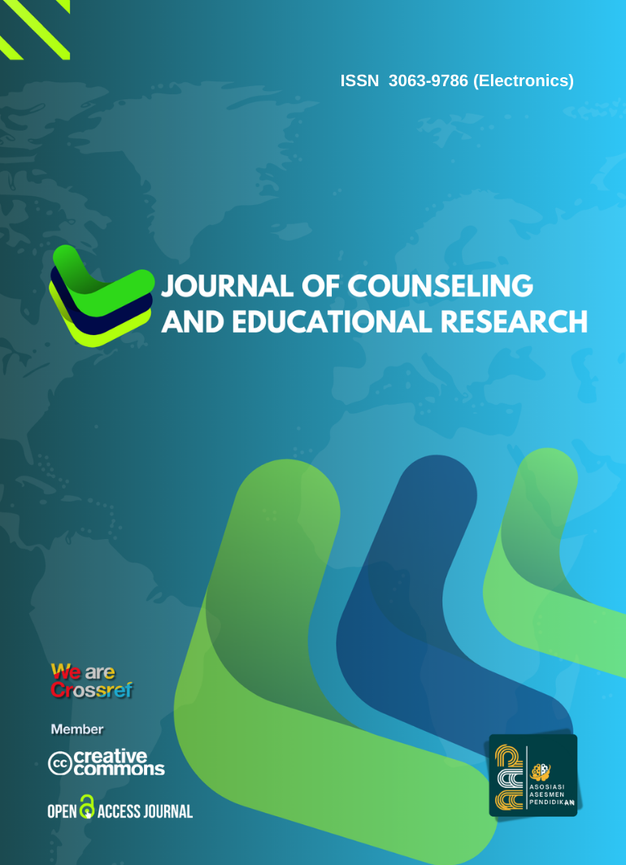The Effect of Loneliness on Nomophobia In Students at Yaspi Senior High School
-
Published: December 28, 2024
-
Page: 72-80
Abstract
The purpose of this study was to determine the description of Nomophobia in students who have feelings of loneliness, to determine the description of students who experience loneliness, and to measure how much loneliness affects Nomophobia in students at SMA Yaspi. Based on the Solvin formula with a 5% error rate, the researcher gave a questionnaire to 88 students with a population of 113 students. This study used the UCLA-LS Version 3 measurement scale for the balance variable and the NMP-Q measurement scale for the Nomophobia variable. The research method used was quantitative. The data analysis technique was carried out using Simple Linear Regression Analysis which was calculated with the help of the SPSS (Statistical Program for Social Science) 27 for windows program. The results of the study Loneliness has a positive and significant effect on Nomophobia in students at SMA Yaspi which can be interpreted that the higher the level of equality felt, the more Nomophobia behavior will increase. This is based on the results of the calculations produced that the tcount value> ttable (2.660> 1.663) so that Ha is accepted. And the calculated F value = 7.075 with a significance level of 0.009 <0.05, then the regression model can be used to predict the participation variable or in other words there is an influence of the Loneliness variable on the Nomophobia variable. The implications of the research results can be used as a guidance and counseling service program creation at SMA Yaspi.
- Loneliness
- Nomophobia
- Students In High School
- Abdullah, K., Jannah, M., Aiman, U., Hasda, S., Fadilla, Z., Taqwin, Masita, Ardiawan, K. N., & Sari, M. E. (2022). Metodologi Penelitian Kuantitatif (N. Saputra (ed.)). Yayasan Penerbit Muhammad Zaini. https://repository.ar-raniry.ac.id/id/eprint/28559/1/Buku Metodologi Penelitian Kuantitatif.pdf
- Ajijah. (2023). Hubungan Antara Kesepian dengan Nomophobia pada Mahasiswa Indekos Universitas Islam Sultan Agung Semarang. https://doi.org/10.1016/j.tranpol.2019.01.002%0Ahttps://doi.org/10.1016/j.cstp.2023.100950%0Ahttps://doi.org/10.1016/j.geoforum.2021.04.007%0Ahttps://doi.org/10.1016/j.trd.2021.102816%0Ahttps://doi.org/10.1016/j.tra.2020.03.015%0Ahttps://doi.org/10.1016/j
- APJII. (2022). Profil Internet Indonesia 2022. SRA Consulting., June, 10. apji.or.id
- Aprilia, N. (2020). Pengaruh Kesepian dan Kontrol Diri Terhadap Kecenderungan Ketergantungan Terhadap Ponsel. 8(2), 249–254.
- Aulia, C., Roswiyani, & Sahrani, R. (2023). Resiliensi: Kunci Mengatasi Kesepian Dewasa Muda. Kompas.Com.
- Bragazzi, N. L., & Puente, G. Del. (2014). A proposal for including nomophobia in the new DSM-V. Psychology Research and Behavior Management, 155–160. https://doi.org/10.2147/PRBM.S41386
- Cibean, T. (2022). Adults in the U.S. check their phones 352 times a day on average, 4x more often than in 2019. Techspot. https://www.techspot.com/news/94828-adults-us-check-their-phones-352-times-day.html
- Cosan, D. (2014). An Evaluation of Loneliness. Mei. https://doi.org/10.15405/epsbs.2014.05.13
- Danuri, M. (2019). Perkembangan dan Transformasi Teknologi Digital. II, 116–123. https://www.researchgate.net/publication/346898118_Perkembangan_dan_Transformasi_Teknologi_Digital?enrichId=rgreq-0b91555b83e016e5254e7883a2ae044c-XXX&enrichSource=Y292ZXJQYWdlOzM0Njg5ODExODtBUzoxMDAyNjA3OTM4MTIxNzMwQDE2MTYwNTE3Njg4OTc%3D&el=1_x_2&_esc=publicationCoverPdf
- Fahira, Z., Amna, Z., Mawarpury, M., & Faradina, S. (2021). Kesepian dan Nomophobia pada Mahasiswa Perantau Loneliness and Nomophobia in Sojourn College Students. 7(2), 183–194. https://doi.org/10.22146/gamajop.65827
- Fajri, F. V. (2017). Skripsi Hubungan antara Penggunaan Telepon genggam Smartphone dengan Nomophobia pada Mahasiswa. https://eprints.ums.ac.id/56457/1/NASKAH PUBLIKASI.pdf
- Gezgin, D. M., Hamutoglu, N. B., Sezen-Gultekin, G., & Ayas, T. (2018). The relationship between nomophobia and loneliness among Turkish adolescents. International Journal of Research in Education and Science, 4(2), 358–374. https://doi.org/10.21890/ijres.409265
- Ghozali, I. (2017). Aplikasi Analisis Multivariate Dengan Program IBM SPSS 23. Badan Penerbit Universitas Diponegoro.
- Hamdi, A. S., & Bahruddin, E. (2014). Metode Penelitian Kuantitatif Aplikasi Dalam Pendidikan (A. Anas (ed.); 1st ed.). deepublish. iPunas
- Heng, S., Gao, Q., & Wang, M. (2023). The Effect of Loneliness on Nomophobia: A Moderated Mediation Model. Behavioral Sciences, 13(7), 595. https://doi.org/10.3390/bs13070595
- IRKaMedia. (2023, May 4). E-Learning: Manfaat dan Tantangan Perkembangannya di Indonesia. Indonesiana.
- Kurniawan, A. W., & Puspitaningtyas, Z. (2016). Metode Penelitian Kuantitatif. Pandiva Buku.
- Manurung, D. M. (2021). Hubungan Kesepian dengan Kecenderungan Nomophobia Pada Mahasiswa Kost.
- Newzoo. (2022). Top Countries by Smartphone Users. Newzoo.Com. https://newzoo.com/insights/rankings/top-countries-by-smartphone-penetration-and-users
- Prasetyo, Y. A. (2017). SKRIPSI Hubungan Antara Kesepian (Loneliness) Dengan Nomophobia pada Remaja (Studi Pada SMAN X) Ditunjukan Guna Memenuhi Syarat Untuk Mendapat Gelar Sarjana Psikologi Pada Fakultas Ilmu Sosial dan Ilmu Politik Jurusan Psikologi.
- Rini, E. S., Abdullah, M., & Rinaldi, M. R. (2020). Kesepian dan Penggunaan Internet Bermasalah Pada Mahasiswa. https://doi.org/10.24036/rapun.v11i2
- Rini, R. A. P. (2022). Riset: Tiga Penyebab Bunuh Diri Terbanyak di Indonesia, Diantaranya Kesepian. Tribunnews.Com. https://www.tribunnews.com/nasional/2022/09/10/riset-tiga-penyebab-bunuh-diri-terbanyak-di-indonesia-diantaranya-kesepian
- Roseliyani, T. D. (2019). Hubungan Intensitas Penggunaan Smartphone dan Kesepian dengan Kecenderungan Nomophobia pada Mahasiswa.
- Russell, D. W. (2010). UCLA Loneliness Scale (Version 3): Reliability, Validity, and Factor Structure. 3891(Version 3). https://doi.org/10.1207/s15327752jpa6601
- Saefullah. (2020, November 30). Pengaruh Kemajuan Teknologi Komunikasi dan Informasi Terhadap Karakter Anak. Balai Diklat Keagamaan Jakarta, Kementerian Agama RI. https://bdkjakarta.kemenag.go.id/pengaruh-kemajuan-teknologi-komunikasi-dan-informasi-terhadap-karakter-anak/
- Safaria, T., Saputra, N. E., & Arini, D. P. (2022). Nomophobia: Riset Teori dan Pengukurannya (R. Purwandari & B. Asyhari (eds.)). UAD PRESS.
- Sagita, D. D., Erwinda, L., & Syahputra, Y. (2020, March). Contribution of the Internet Uses to Student Morale: Study in High School. In International Conference on Progressive Education (ICOPE 2019) (pp. 330-332). Atlantis Press.
- Sesva, M., Syahputra, Y., & Erwinda, L. (2022). Predicting Social Media Addiction in Adolescent with Narcistic Variables: Predicting Social Media Addiction in Adolescent with Narcistic Variables. Journal of Learning and Instructional Studies, 2(2), 13-20.
- Santrock, J. W. (2002). Life-Span Development : Perkembangan Masa Hidup. Erlangga.
- Sobon, K., & Mangundap, J. M. (2019). Pengaruh Penggunaan Smartphone Terhadap Motivasi Belajar Siswa. 3(2), 97–106. https://doi.org/10.26858/pembelajar.v3i2.9851
- Sugiyono. (2017). Metode Penelitian Kuantitatif, Kualitatif, dan R&D. Alfabeta.
- Syahputra, Y., & Erwinda, L. (2020). Perbedaan Nomophobia mahasiswa; analisis Rasch. JPPI (Jurnal Penelitian Pendidikan Indonesia), 6(2), 69-76.
- Syahputra, Y., Prayitno, P., Syahniar, S., & Hariyani, H. (2019). Rasch stacking analysis of student internet addiction based on gender. Jurnal Konseling Dan Pendidikan, 7(1), 35-41
- Wardana, J. (2021). Awas, Bahaya Kesepian di Tengah Abad Modern. Tempo Publishing.
- Yildirim and Cooreia. (2014). Exploring The Dimensions Of Nomophobia: Developing and Validating a questionnaire using mixed methods research. Computers in Human Behavior, 5(2), 3–20.
- Yuwanto, L. (2010). Mobile Phone Addict. Putra Media Nusantara.












